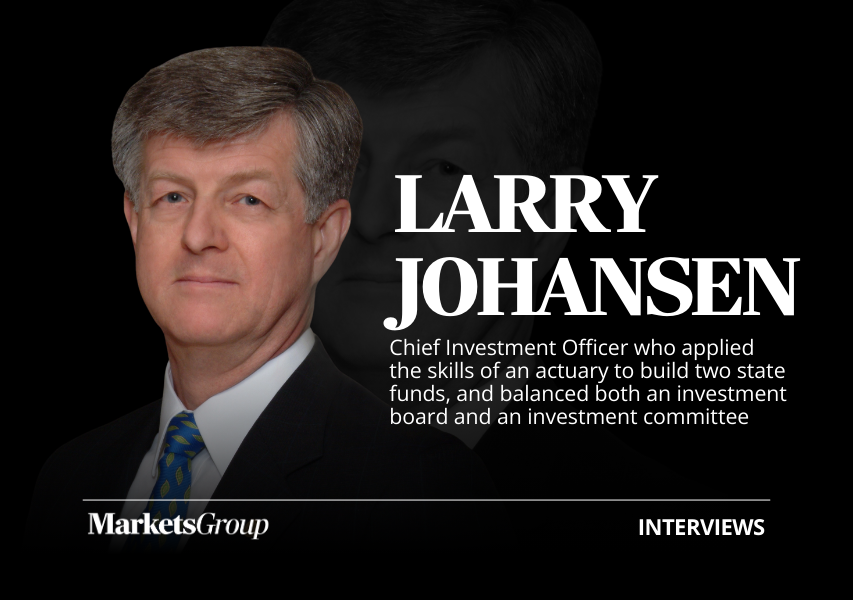Listen on Spotify
Watch video here:
Larry Johansen shares how actuarial insight drove 9.3% returns and doubled assets. He will be given a Lifetime Achievement Award in Boston during the 12th Annual New England Institutional Forum on Sept 17-18. Reserve your seats now.
Larry Johansen is the former CIO of the New Hampshire Retirement System. Under Johansen’s leadership, the fund consistently achieved returns above the assumed return rate of 6.75%, averaging 9.3% over his last 10 years there, net of fees, and before he retired during the pandemic year of 2022.
During his tenure, from June 30th, 2010, to June 30th, 2021, the New Hampshire Retirement System Trust Fund’s assets more than doubled, growing from $4.9 billion to $11.6 billion.
During this interview, we will learn how starting his career as an actuary made quite a difference. We will also discuss what was important in building the framework between and behind two successful funds where he worked: the New York State Teachers’ Retirement Fund and the New Hampshire Retirement System. We’ll learn what it was like to answer to both a retirement board and investment board, while maximizing returns, minimizing risks, and keeping the plan well funded.
Note: MarketsGroup will be honoring Larry Johansen with a Lifetime Achievement Award during our investment forum in Boston for institutional investors. That’s September 17th to the 18th, 2025. We will celebrate his lifetime, his career, and what he contributed to this industry.
Christine Giordano: Welcome, Larry.
Larry Johansen: Thank you.
Giordano: Thank you for being here. Let’s jump right in because your career has been a bit different than that of most CIOs. You started your career as an actuary for the New York State Teachers Fund. Can you describe how that happened and what you did there?
Johansen: Sure. When I started in the early 70s at New York State Teachers, I was an entry-level actuary. Studied the exams, ultimately became the system’s chief actuary. During that time, the retirement system hired its first investment consultant in the early 80s.
We had used, in the early days of the retirement system, Buck Consultants, an actuarial firm, as our actuary. They had a subdivision, Buck Pension Fund Consultants, that did investment consulting. We hired them in the early 80s. Since it was within the actuarial firm, it was decided that I would be the liaison between the investment consultant and the retirement system.
We embarked upon an asset allocation study, developed the asset allocation study that the board ultimately approved, and hired multiple managers and managed a significant amount of assets, all of the fixed income and most of the passive equities internally. That structure, along with disciplined rebalancing as the rules required, helped us to be a very successful fund.
Giordano: In working as one of the initial employees that developed the New York State Teachers Fund, how was your approach different because you were an actuary? What were some of the ingredients there that were very important to get right?
Johansen: I think there’s a couple of key components to that. One, an actuary’s time horizon is a very long time horizon. By the time you hire an entry-level teacher in the early 20s and he or she retires in their 50s or 60s, and then lives another 20 or 30 years, that’s a very long time horizon, obviously longer than most investment time horizons. The long time horizon, I think, is very important.
The other thing I think is very important is understanding the nature of the liabilities. Is it a contributory plan? What happens with members’ contributions? Is that part of the pension benefit, or is there a separate benefit related to the member contributions? Is there a COLA, or is it a fixed plan?
If it’s a fixed plan with no COLA, the liabilities are stable and don’t increase unless there’s ad hoc increases along the way granted by the legislature. If there’s a COLA, that the liability is going to increase over time with inflation. Are there floors or ceilings to the COLA?
Understanding the nature of the liabilities and the very long-term nature of those liabilities, I think, is very helpful in developing an investment plan for a retirement system.
Giordano: Larry, you were also one of the first CIOs in New Hampshire at the retirement system.
Johansen: That’s correct. My predecessor was there for a few months. The legislature had restructured the retirement system in 2007, 8, and 9. They put the plan on a more traditional actuarial funded method, amortized the unfunded liability over 30 years, and created in January of ’09 an independent investment committee.
The board at the time was a 13-member board, and the investment committee was 5 members, 3 of whom were independent of the retirement system, 2 of whom were from the board, appointed by the board chair. All five of the individuals had to have broad and deep investment experience. They made a recommendation to the board for the asset allocation.
Once the board adopted an asset allocation, the investment committee made all the other investment decisions. They hired the managers, monitored the managers, and when appropriate, replaced the managers. They decided how much of the equity allocation was passive, how much was active, how was it active, was it large, was it small.
You had what I think is unique in public plan space, investment professionals making the investment decisions. They brought me in 2010. My predecessor, as I mentioned, had lasted just a few months. We worked collaboratively to set the asset allocation that was ultimately approved by the board and then filled it in over time to what turned out to be a very successful program.
Giordano: That’s quite the building blocks there. How was it to actually have a board and a committee to answer to?
Johansen: In the beginning, it required a lot of diplomacy. The board, up until January 1 of ’09, had made all the investment decisions. Part of the reason in the legislative history for the changes was, it was believed that those decisions were less than optimal.
The legislature created the independent investment committee, and working with a brand new structure, especially interacting with board members who were used to making those decisions, no longer had the authority to make those decisions, required a lot of diplomacy.
Giordano: What were some of the more challenging years that really tested your mettle?
Johansen: I think that COVID certainly comes to mind, although by then much of what we had in place was in place and moving along. I think 2011 was one of the more challenging years. The legislature did two significant things.
One, they changed the benefit structure for non-vested members, reducing benefits to reduce future liabilities. In addition, they restructured the entire board. The board went from 13 members to 11. It was a much more diversified and more representative board. It was difficult. As board members, you got used to and understood were replaced by new and completely different people and different backgrounds. That became a real challenge, especially so early in my career there. In addition, our executive director had left to move on to Illinois. We had an interim executive director. It was a lot of moving parts.
Giordano: I bet. Sometimes during COVID, your managers would find out that they were fired before you could tell them.
Johansen: Yes. That became a bit of a challenge because of the open meetings law. While we were meeting via Zoom or one of the devices like that and all remotely, the discussion over a manager termination was permitted to be in executive session.
However, ultimately, the decision was required to be in public session unless there were some extenuating circumstances, so because of the open meetings law, people were allowed to call into the meeting as opposed to traveling up from New York or Boston, or some other place, to attend the meeting in person, when before COVID.
When the committee would decide to replace a manager, by the time the meeting adjourned and I called the manager to discuss the transition, the manager already knew that they had been terminated. Those were often challenging conversations.
Giordano: What would be your advice in the future if that had to happen?
Johansen: I’m not sure it can be avoided. The public has a right to know what’s going on with public entities. We set up the Zoom for everyone’s convenience so that people weren’t interacting in person during the peak of the COVID pandemic. I’m not sure there’s a way to avoid it.
Giordano: Okay. Now, similarly, in your securities lending program, you learned that even though things might seem to be liquid, they aren’t liquid if you cannot sell them. You were given the mandate to get out as quickly as possible without losing money. What did you do?
Johansen: That was one of the problems both the committee and I inherited during the financial crisis. The gates came down on our securities lending program, and you were limited to how much you were allowed to withdraw from the program. The rules were very clear. It was based upon last month’s AUM and other contributing factors.
Every month, we would figure out exactly how much we were allowed to withdraw and call up the bank and withdraw it. We were able to get out more quickly than the path that was started before I arrived. The committee was pleased, and we were able to extricate ourselves with as little pain and aggravation as possible.
Giordano: How long did it take you to get out?
Johansen: If my recollection is correct, I think it took us about 12 or 15 months.
Giordano: Were they pleased?
Johansen: They were very pleased, yes.
Giordano: Nice. How much was in that program?
Johansen: Securities lending has become a dirty word at this point.
[laughter]
Johansen: It’s like everything else. If you set up the parameters correctly, you can avoid those kinds of things. We had a very successful securities lending program at New York State Teachers, and rarely, if ever, did we have an issue. A lot of it just depends on how you set up the program in the beginning, what we’re allowed to be in the asset pool.
What happened, it was a classic problem that insurance companies come in, it was a mismatch between assets and liabilities. The assets were longer-term. The liabilities were obviously overnight, and that is what created the problems.
Giordano: I see. Was that in the Lehman Brothers years?
Johansen: No, this was just after the Lehman Brothers, yes.
Giordano: Yes, okay. When it was set up correctly at New York State Teachers, the assets and liabilities were well matched, and their duration was also matched.
Johansen: Correct.
Giordano: Yes, okay. From your perspective, also as an actuary, what were some overlooked things that are very important to get right when building that framework? I think in our earlier discussions, you mentioned custodial banks.
Johansen: Yes. I think the partners that you work with are very critical. The custodial bank is obviously very important to make sure that they have the systems that you need to know what you have when you have it, and what the real values are.
As the securities lending example is, you may think something’s liquid, but if you can’t sell it, it’s not liquid. You really need to understand the nature of the assets that you have, whether it’s securities lending or just regular assets, so that you don’t end up in that classic mismatch of assets and liabilities.
Giordano: With a team of four, you more than doubled New Hampshire’s AUM from 5 billion to 12 billion, even though the fund had a negative cash flow. What were some of the best programs that you put into place in order to make that happen?
Johansen: I think, one, the core domestic equity program was in an S&P 500 index. The S&P 500 has a qualitative component to it. It’s a difficult index to long-term do better than. If you look over the last number of years, virtually nothing has beat the S&P 500, so it’s clearly a significant component. We very carefully reviewed the entire real estate program.
We owned, at the time, individual properties. We worked very closely with the real estate consultant to sell those properties and move into longer-term funds. We were able to aggregate with other clients and get fee discounts. We were able to unload all of those individually owned properties and aggregate at a small profit, so we didn’t lose any money there, which is a very important component.
The real estate portion of the portfolio was consistently in the top decile of comparable programs, so that was a very successful program. Building out the private equity and private credit program, we did very slowly and deliberately, and that became a significant success, too.
Giordano: You were elected president of the Academy of Actuaries and also won the Robert Meyers Award for Public Service a few years ago. What made you so successful, and what were some of your responsibilities in doing those things?
Johansen: I think one of the responsibilities of the American Academy of Actuaries is professionalism, and the other is public policy. It’s the umbrella organization for the actuarial organizations in the U.S. One of the things under public policy is, the Academy provides factual analysis and doesn’t take sides.
One of the interesting outcomes of that was during the 2000 presidential campaign. I was president of the Academy during the last stages of that campaign, and the Academy had put together a white paper analyzing both candidates’ proposals for Social Security. You remember the catchphrase, “the lockbox.”
The Academy’s white paper basically said neither proposal works. The Gore campaign picked that up and said that his opponent’s plan didn’t work, as demonstrated by the Academy’s white paper. The Bush campaign called us up and said, “Why are you being biased? I thought you were honest brokers.”
We said, “Well, we actually said the same thing about Mr. Gore’s proposal, but he used it, you didn’t. That’s not our fault.” It was an animated conversation, but it ended well, and we all know how the election turned out. It had virtually no impact on the election.
Giordano: Educating Capitol Hill cannot be so easy sometimes.
Johansen: No, that’s for sure.
Giordano: In approaching your lifetime and looking back at your career, how has being an actuary changed things for you or changed your approach in a way that maybe other CIOs didn’t have that approach because they didn’t have your background?
Johansen: Harking back to my early response, I think, two things. One, I have a very long-term perspective. Mentioning when a teacher joins and ultimately is no longer retired. Two, you think of things in probabilities.
I know one of my former investment committee members used to say, “This is how it’s supposed to work.
You’re supposed to think in probabilities.” Without the mathematical background, I don’t think you do think in probabilities. I think that’s been very helpful to me along the way.
Giordano: You’re also known for your honesty and for keeping risk low at your fund and maximizing your returns. What is the key to bringing that all together?
Johansen: Being able to explain what it is you’re doing. Now, explaining it to the investment committee, because they all have an investment background, is relatively easy. Explaining it to a board of trustees, who want to understand what’s going on but typically don’t have the investment background, I think, again, my actuarial background helped. Explaining actuarial concepts to non-actuaries is a bit of a challenge.
Explaining some of the investment concepts to people without a broad investment background can be equally challenging. You need to bring honesty and integrity so that you’re always being upfront with people, and if they don’t understand, you approach it in a different way. I think getting the buy-in is the real critical thing, and integrity is part of that buy-in.
Giordano: Makes a lot of sense. Let’s take a minute and play a little verbal ping-pong where I say a word and you say the first thing that comes to mind. Sound good?
Johansen: Okay.
Giordano: Russell 3000.
Johansen: It’s a broad index, but I think the S&P is a better index.
Giordano: Leading edge.
Johansen: I really call it bleeding edge.
Giordano: Investments in China.
Johansen: Opaque. I think that I’ve spoken to many people who spent long periods of time in China. I think they readily admit that it’s very difficult to really fully understand what’s going on in China.
Giordano: Best investments around tariffs.
Johansen: Tariffs have created some huge uncertainties, added to the volatility. I think with every crisis or pending crisis or perceived crisis, stick to your knitting. You’ve established a long-term asset allocation, rules for rebalancing. Stick to the path.
Giordano: Funded level.
Johansen: Higher is better. Everyone works to improve their funded status. New York State Teachers’ is an extremely well-funded plan. New Hampshire is working very diligently on its plan and is improving every year.
Christine: Do you know what New Hampshire was up to by the time you left?
Johansen: I think it was in the mid-60s. It started in the mid-50s when I got there, and it was now in the mid-60s. They’ve made significant progress.
Giordano: Going in the right direction.
Johansen: Correct. Yes.
Giordano: Your favorite hobby in retirement?
Johansen: Tutoring my grandchildren high school math.
Giordano: The best thing about being a CIO?
Johansen: I think the best thing about being a CIO was the ability to get to know some extremely bright people and learn from those bright people. Even a smaller plan like New Hampshire has incredible resources, external resources at their disposal if you take advantage of it. Meeting and getting to know bright people, learning from them, and availing yourself of the resources that are there.
Giordano:: Beautiful. It’s a blessing we both share. [laughs] As a journalist, I appreciate that.
Johansen: I bet.
Giordano:: [laughs] Very much looking forward to celebrating you, Larry, with a Lifetime Achievement Award on September 18th in Boston. Thank you so much.
Johansen: Looking forward to it, too.
Giordano: That’s Larry Johansen, Former CIO of New Hampshire Retirement System. Thank you, Larry.
Johansen: Thank you.













